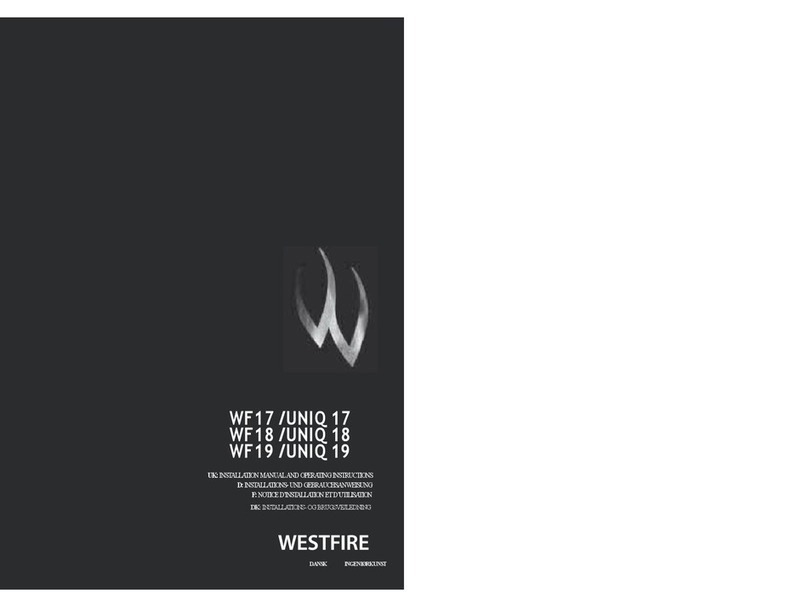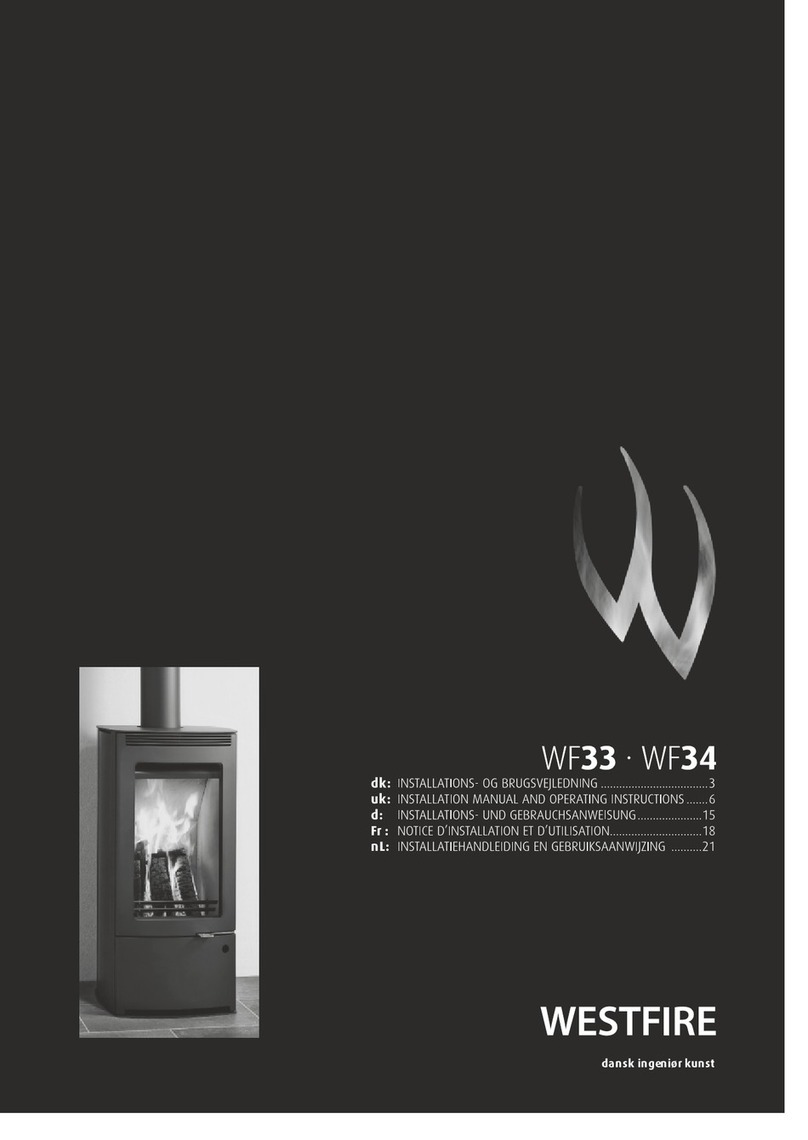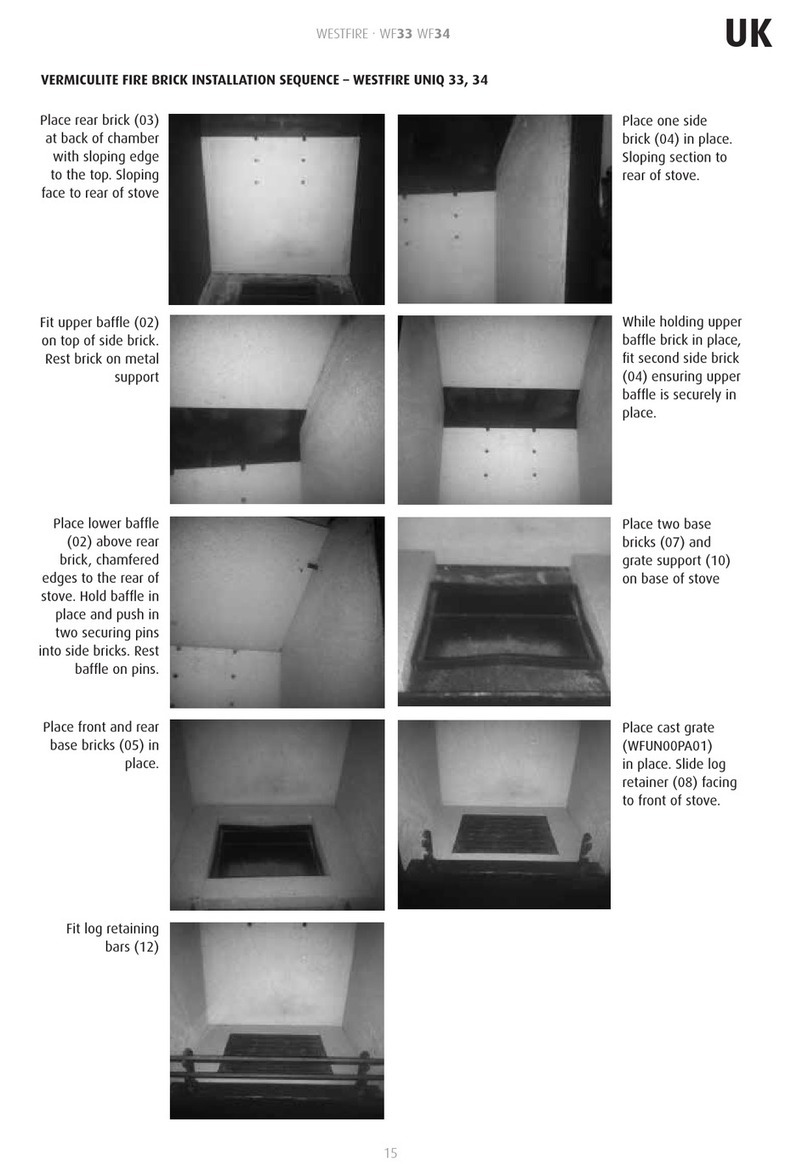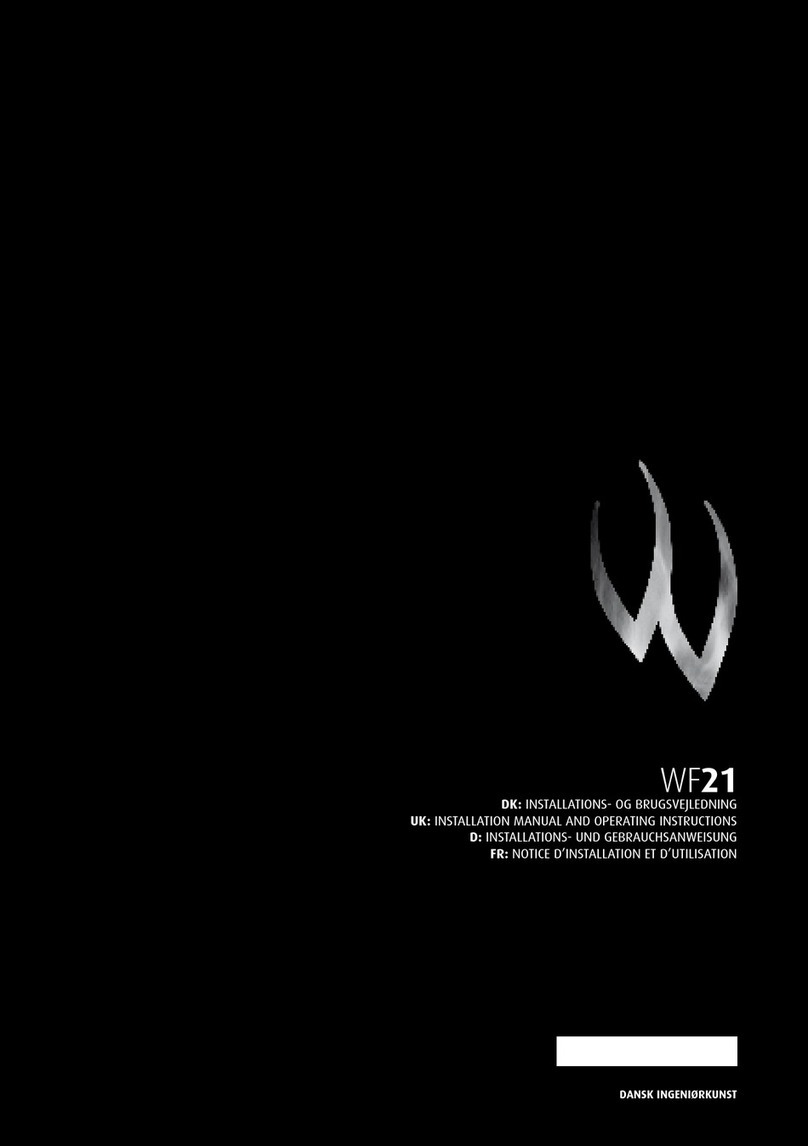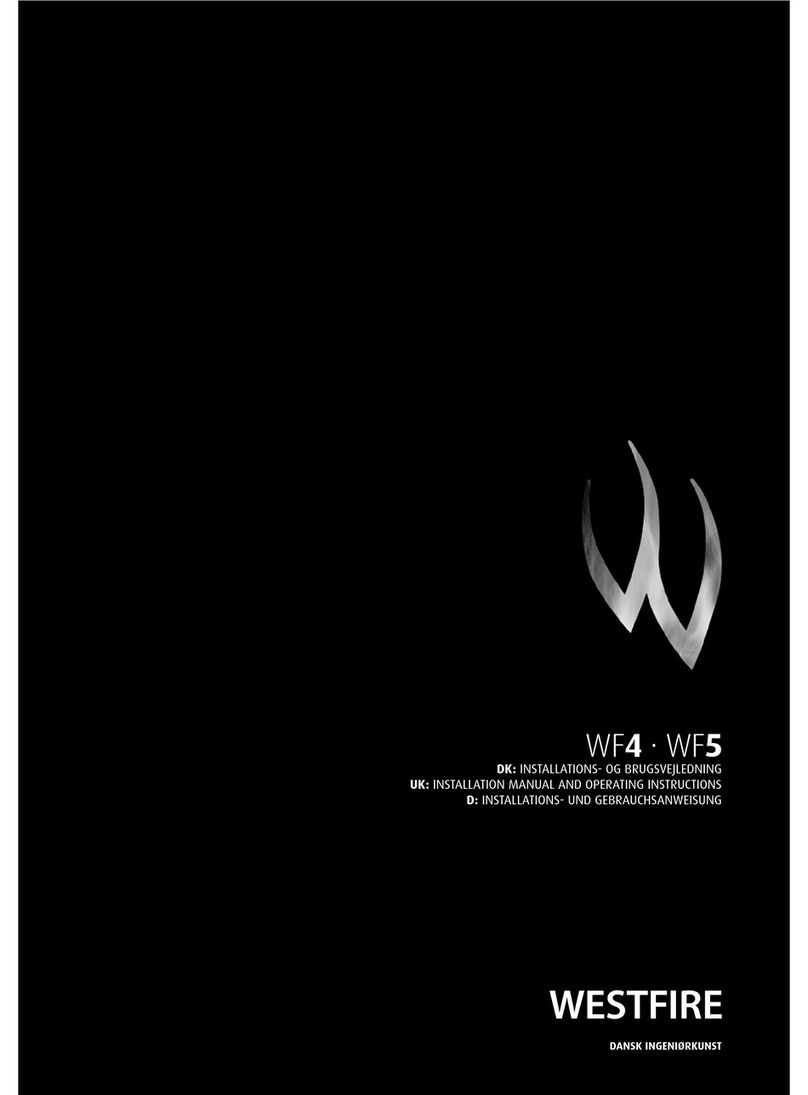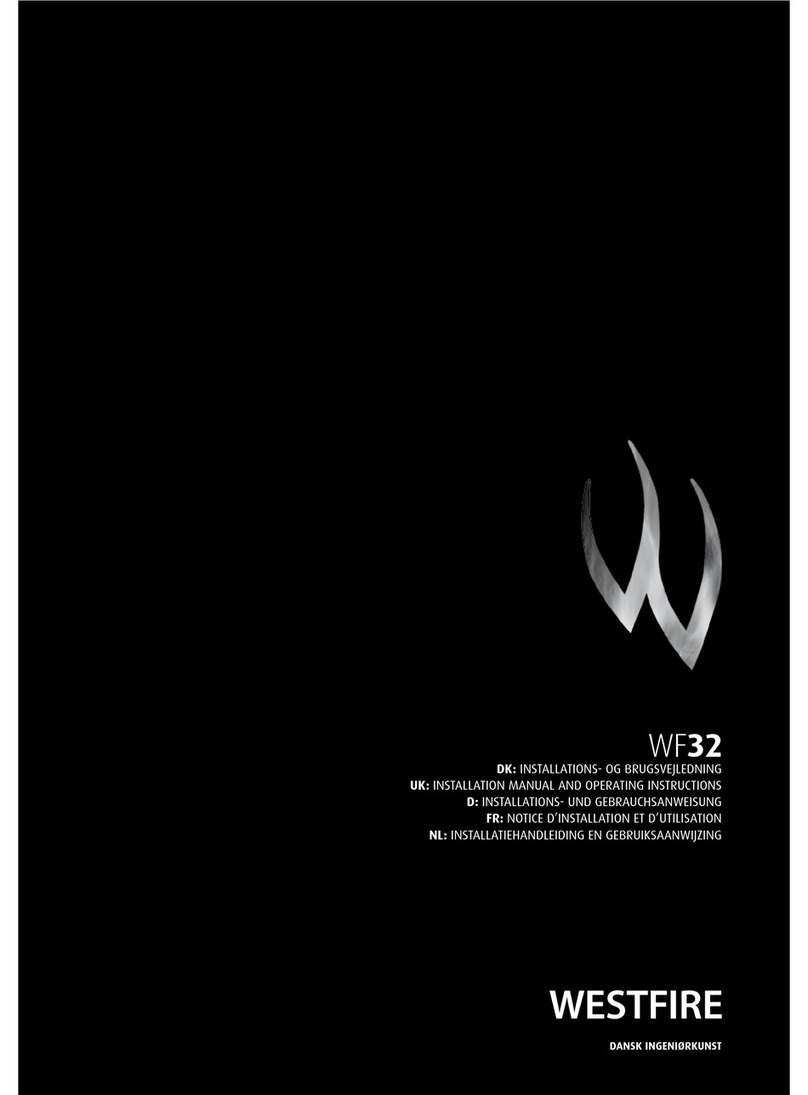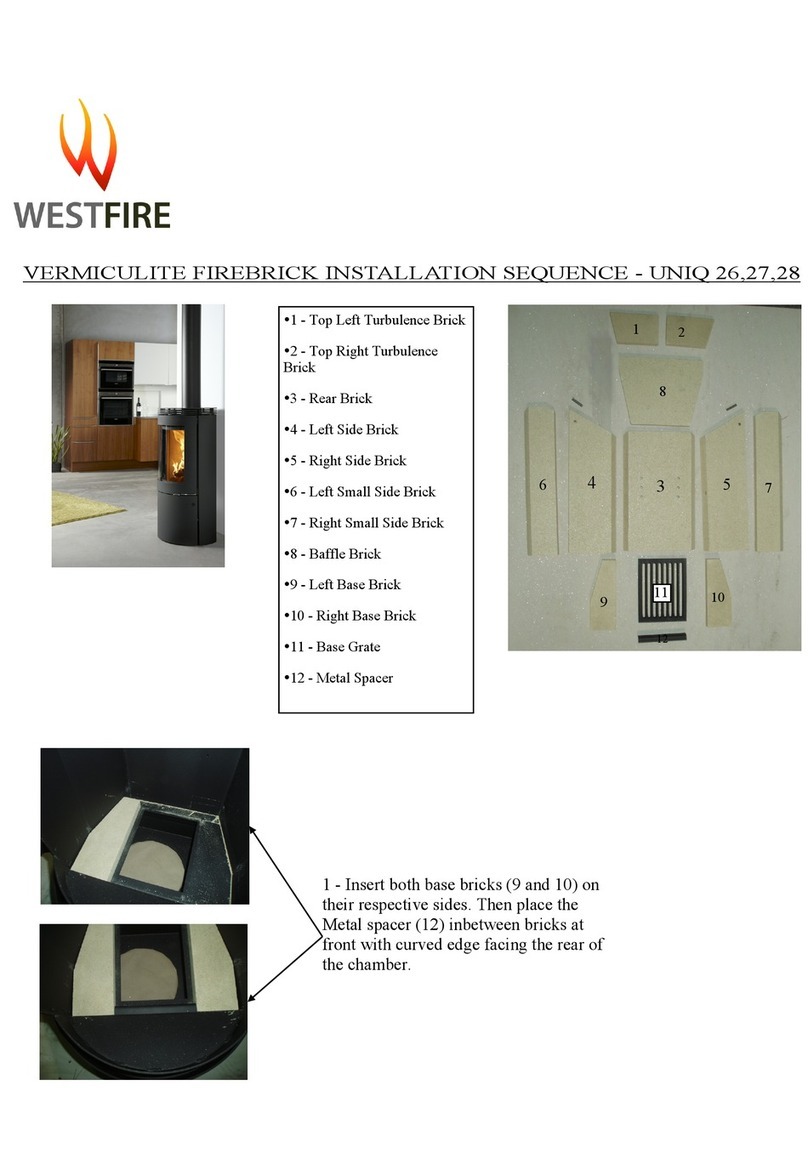MAINTENANCE
Ash must be removed from the stove at regular intervals.
The stove must be completely cold before being cleaned. The outside should be cleaned using a dry cloth. The
inside of the stove should be cleaned once a year. To clean the inside, remove all ash, soot and tar residue from
the combustion chamber. The smoke plate should be removed as dirt and soot will collect behind it. The packing
cord in the door will wear over time and should therefore be checked.
The stove, the flue pipe connection and the chimney should be checked regularly by a qualified engineer. The
chimney should also be checked for blockages before relighting the stove if it has not been used for an extended
period of time.
The lacquer may wear thin in exposed places due to overheating. This, and other lacquer damage, may be
repaired using a special senotherm lacquer spray available at all stove outlets.
Ash must be stored in a non-combustible container and must not be mixed with other combustible waste.
The combustion chamber is lined with Skamol. These panels will wear over time and will therefore need
replacing. The same is true for the smoke plate.
A Skamol panel may crack if hit too hard by a piece of firewood. This has no effect on the function of the stove
(this is not the case with the smoke plate). The Skamol panels will only need to be replaced once they become
very worn and are no longer whole, or if they crack in several places.
The air damper and the stove door must be closed in the event of overheating.
OPERATING PROBLEMS
Soot forms on the window: The firewood may be too wet, or the intake of secondary air may be insufficient.
The wood burns too quickly: The chimney draft may be too strong, or there may be a leak near the door of the stove.
The stove fails to heat fully: The firewood may be too wet.
Smoke or odour: Weak chimney draft – check for blockages in the flue pipe/chimney and check the height of the
chimney in relation to the surroundings.
Soot in the chimney: The firewood may be too wet, or the intake of secondary air may be insufficient.
GUARANTEE
Your new stove is covered by a five year guarantee against manufacturing defects. Your receipt documents the
date of purchase. The guarantee does not cover damage caused by faulty operation such as overheating or the
stove being incorrectly connected, or damage which occurs as a result of external physical force.
The guarantee does not cover damage to replaceable parts, transport costs associated with repairs under warranty
or the installation/dismantling of the stove in connection with repairs under warranty.
Warning! Any unauthorised modification of the appliance is forbidden.
Only replacement parts recommended by Westfire ApS should be used for repairs.
D: INSTALLATIONS- UND GEBRAUCHSANWEISUNG – WESTFIRE WF18
Diese Anweisung bezieht sich auf nachfolgend genanntes Modell, das gemäß den Vorschriften der Norm
CE/EN 13240 geprüft wurde.
Wir beglückwünschen Sie zum Erwerb Ihres neuen Westfire Kaminofens! Damit Sie viel Freude daran haben,
bitten wir Sie, diese Gebrauchsanweisung sorgfältig durchzulesen, denn so lassen sich Probleme vermeiden.
Wenn Sie sich bezüglich Aufstellung/Anschluss und Betrieb des Modells WF 18 eingehender informieren möchten,
verweisen wir auf das Faltblatt „Brandstättenverordnung“, das Sie bei Ihrem Fachhändler oder bei dem für Sie
zuständigen Schornsteinfegermeister anfordern können. Dort können Sie sich auch über das ordnungsgemäße
Befeuern informieren.
AUFSTELL- UND ANSCHLUSSANLEITUNG
Bei Aufstellung/Anschluss Ihres Kaminofens sind Gesetze und Bestimmungen einzuhalten, die in den örtlichen
Bauvorschriften nachzulesen sind. Diese besagen, dass bei geschlossenen Feuerstellen brennbare Fußböden
bis mindestens 30 cm vor der Feuerungsöffnung und mindestens 15 cm zu jeder Seite abgedeckt sein müssen.
Die schützende Unterlage muss aus nicht brennbarem Material wie z. B. Stahl- oder Glasplatten, Klinkern oder
Kunstschieferplatten bestehen.
Der Fußboden muss dort, wo der Kaminofen stehen soll, ausreichend tragfähig sein.
Der Abstand zu brennbaren Materialien gem. EN 13240 geht aus dem Schild auf der Ofenrückseite hervor.
Bei nicht brennbaren Wänden gibt es keine Vorschriften für den Abstand, jedoch empfehlen wir wegen der
Reinigung mindestens 10 cm hinter dem Ofen frei zu lassen.
Weil Verbrennung Luft erfordert, ist für eine ausreichende, nicht blockierbare Frischluftzufuhr in den Raum
zu sorgen, wo der Kaminofen steht. Dabei kann es sich um ein offenes, ausreichend dimensioniertes
Belüftungsventil oder ein am Ofen angeschlossenes Frischluftsystem handeln.
Alle Kaminöfen von Westfire sind mit einer Rauchumlenkplatte ausgestattet, sodass der Weg, den der Rauch
nimmt, möglichst lang ist.
ANSCHLUSS AN SCHORNSTEIN
Der Schornstein muss einen Durchmesser von mindestens 15 cm aufweisen, was einer Öffnung von 175 cm²
entspricht.
Er muss zudem eine Höhe haben, die ausreichend Zug gewährleistet und dafür sorgt, dass es zu keiner
Rauchbelästigung in unmittelbarer Nähe kommt. Schließlich muss er mit einer leicht zugänglichen
Reinigungsklappe versehen sein.
Min. Schornsteinzug (Prüfwert): 12 Pa. Max. Schornsteinzug: 25 Pa.
Rauchgasfluss: 4,2 g/s.
Rauchgastemperatur: 272°.
Das Modell WF 18 verfügt über eine Rohranschlussmöglichkeit oben und an der Rückseite.
Das Rauchrohr ist mit einer Regulierklappe erhältlich, die es ermöglicht, den Schornsteinzug an Tagen mit starkem
Wind zu regulieren. Sie darf sich nicht vollständig schließen lassen, d. h., der freie Durchgang muss mind. 20 cm²
betragen.
Eine Verringerung des Schornsteinzugs kann auch auf andere Weise herbeigeführt werden, etwa durch Luftzufuhr
im Schornsteinbereich.
BEDIENUNGSANLEITUNG
Da der hitzebeständige Lack beim ersten Anheizen des Kaminofens aushärtet, können sich Gerüche und Rauch
bilden. Aus diesem Grund ist für gute Belüftung zu sorgen.
Abstand hinten (cm) Abstand seitlich (cm) Abstand zu Möbeln, vorn (cm)
WF 18 17,5 cm 30 cm 85 cm
UK D



